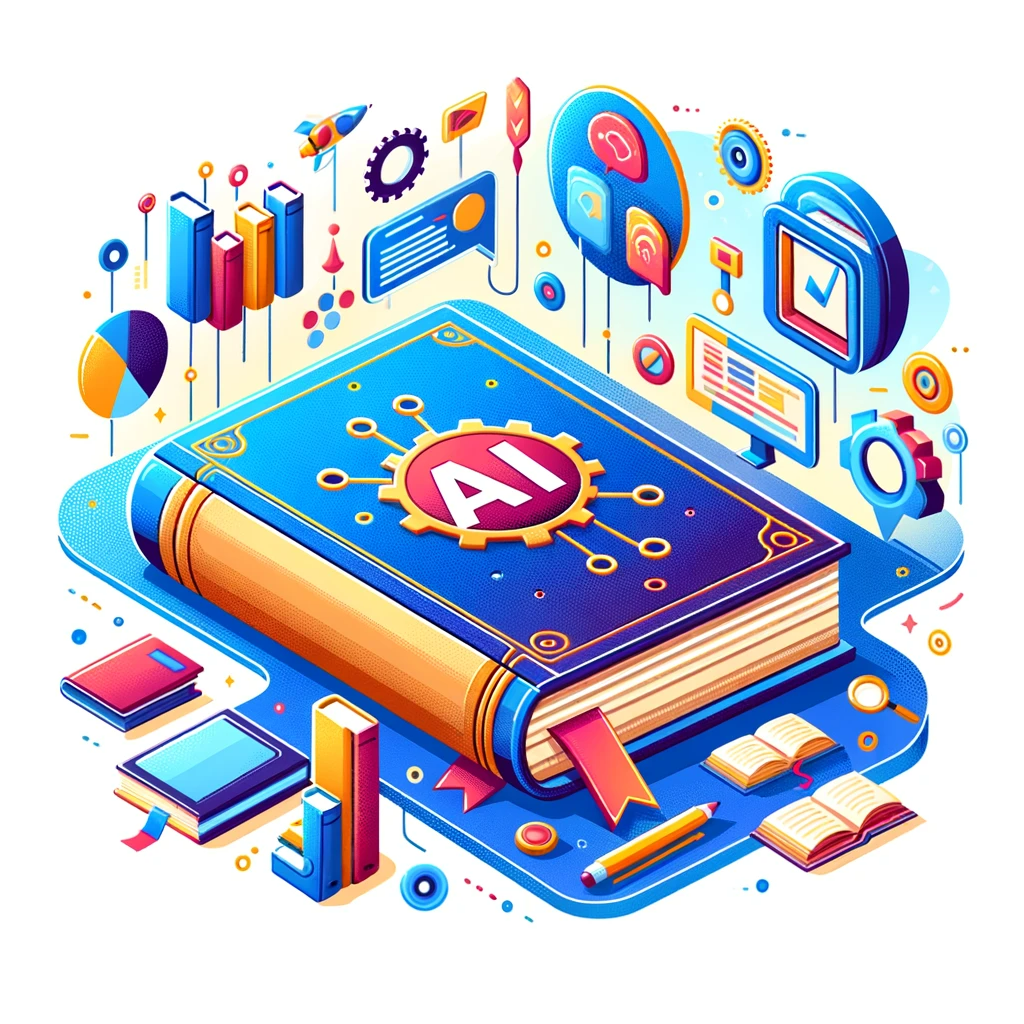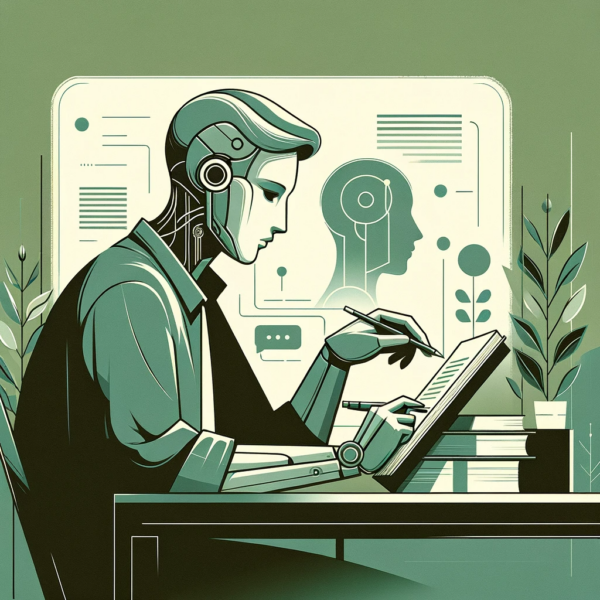The book publishing industry is undergoing a significant transformation with the integration of Artificial Intelligence (AI). From editing and formatting to marketing and reader engagement, AI is revolutionizing various aspects of the publishing process. With nearly 54% of publishers already adopting AI for content enhancement and workflow automation, its impact is undeniable.
AI-driven tools have made significant advancements in editing, grammar checks, and design optimization, helping authors refine their work more efficiently. For instance, AI-powered editing software can reduce editing time by up to 30%, ensuring consistency and accuracy while allowing authors to focus on creativity. Additionally, AI plays a crucial role in marketing, enabling publishers to analyze reader trends and optimize book discoverability.
However, while AI offers remarkable efficiency, it should never replace the essence of what makes books meaningful—the human touch in storytelling. AI-generated writing often falls short, lacking originality, emotional depth, and narrative richness—the very elements that make stories compelling. AI struggles with context, tone, and nuance, often resulting in flat and uninspired narratives.
This article explores how AI is reshaping the publishing landscape, the key advantages it offers, and why writing should always remain a human-driven art form. We’ll examine AI’s role in streamlining the publishing process while reaffirming the irreplaceable value of human creativity in storytelling. Finally, we’ll highlight how Spines leverages AI to assist authors—enhancing editing, formatting, and design—so they can focus on what truly matters: crafting stories that captivate, inspire, and resonate with readers.
Brief History of Book Publishing: From Traditional Methods to Digital Transformation
The story of book publishing begins with handwritten manuscripts in ancient civilizations, where books were rare and costly. The invention of the printing press by Johannes Gutenberg in the 15th century revolutionized the industry, making books more affordable and accessible to the masses. This shift democratized knowledge and laid the foundation for modern publishing.
In the centuries following Gutenberg’s innovation, publishing houses grew to manage the printing, marketing, and distribution of books. The mass-market paperback in the 20th century made literature even more accessible, further expanding the reach of books.
The Digital Revolution
The late 20th and early 21st centuries saw the rise of e-books and digital printing, drastically altering how books are produced and consumed. E-readers and tablets enabled readers to access vast libraries instantly, marking a shift to digital publishing. This transformation also gave rise to self-publishing platforms and online book sales, empowering authors to reach global audiences directly.
AI’s Role in Modern Publishing
Today, the publishing industry is adopting AI technologies, such as natural language processing (NLP) and machine learning, to enhance efficiency across various stages of the publishing process. These tools are streamlining tasks like editing, designing, and marketing, significantly reducing the time and effort required for each. AI is also enabling publishers to predict reader preferences, optimize content discoverability, and make data-driven decisions. By automating time-consuming processes, AI allows publishers to focus more on creativity and strategy while ensuring faster, more efficient workflows.
AI Publishing Trends
The integration of Artificial Intelligence (AI) in the publishing industry is reshaping traditional workflows and introducing innovative practices that are transforming how content is created, marketed, and distributed. AI technologies like natural language processing (NLP), machine learning, and predictive analytics are automating time-consuming tasks and providing insights that were once difficult to obtain. This not only streamlines the publishing process but also enhances efficiency, speed, and personalization at every stage.
In a recent survey, 68% of publishers revealed that they believe AI will significantly enhance content production. This data suggests that publishers are not simply experimenting with AI—they are embracing it as a game-changer for operational efficiency. Publishers are increasingly recognizing AI’s potential to handle repetitive tasks, provide data-driven insights, and support creative processes, allowing teams to focus on high-value activities.
- AI-Assisted Editing & Proofreading
AI-powered tools are automating tasks such as grammar checks, style improvements, and consistency analysis, enabling editors to refine manuscripts more efficiently. Approximately 40% of publishers are utilizing AI for editorial tasks, including proofreading and plagiarism detection. - AI-Optimized Book Design
Designing a book’s layout and cover is increasingly influenced by AI-driven design tools that generate layouts and create cover designs based on market trends. These tools help improve visual appeal and alignment with reader preferences, leading to quicker turnarounds and more data-informed decisions in the design process. - Predictive Analytics for Marketing
AI’s ability to analyze vast datasets is transforming how publishers approach marketing. Predictive analytics allows them to forecast trends, optimize book recommendations, and personalize marketing strategies. By leveraging AI algorithms, publishers can anticipate shifts in reader interests before they fully emerge, enhancing the effectiveness of promotional efforts. - Enhanced Book Discoverability
AI is playing a key role in increasing the visibility of books through recommendation engines that suggest books to readers based on their preferences. This not only improves the reader experience but also boosts sales by making books easier to discover.
These trends highlight AI’s transformative role in the publishing industry, enhancing efficiency, personalization, and market responsiveness. For more insights on AI’s impact in this area, check out this Forbes article.
AI in Manuscript Development and Editing
The advent of Artificial Intelligence (AI) in manuscript development and editing marks a significant leap in how authors and publishers approach the creation of literary content. AI’s integration into these processes is not about replacing the human touch, but about augmenting the creative and editorial capabilities of writers and editors, enabling them to produce high-quality manuscripts with greater efficiency.
AI-Powered Tools for Manuscript Development
AI is not here to write books for authors, but to serve as a creative collaborator. While AI tools can be incredibly helpful, they should never replace the unique creativity and voice of the human author. Advanced AI writing assistants are designed to offer suggestions for plot development, character arcs, and even thematic elements, helping authors brainstorm ideas, refine their storytelling, and overcome creative challenges. These tools use machine learning algorithms to analyze vast databases of literature, providing inputs that are contextually relevant and can spark new directions for the writer.
AI tools are meant to enhance creativity, not to take over the writing process. They can help overcome writer’s block, suggest new ideas, or provide inspiration when the direction seems unclear. However, it’s essential to remember that AI is an assistant, not a replacement. The final work always carries the distinct touch of the human author—the person who brings the story to life with their own voice, emotions, and experiences.
Automated Editing Software: Grammar, Style, and Consistency Checks
Editing is an essential step in the publishing process, ensuring that the manuscript is polished, coherent, and reader-friendly. AI has greatly improved this phase by introducing automated editing software that goes beyond basic grammar and spelling checks. These tools are sophisticated enough to analyze complex aspects of writing, such as style, tone, and narrative consistency.
AI-powered editors can assist human editors by providing feedback on sentence structure, readability, and even highlighting potential plot inconsistencies or factual inaccuracies. This level of detailed analysis significantly reduces the time and resources spent on manual editing, allowing authors and editors to focus on high-level creative decisions while AI handles the more technical aspects.
Predictive Analytics for Content Success
AI is also playing a pivotal role in predicting the success of content. By analyzing reader preferences, market trends, and historical data, AI tools can offer valuable insights into which themes or genres are most likely to resonate with audiences. This allows publishers and authors to make more informed decisions about manuscript development, target audiences, and marketing strategies.
The integration of AI in these early stages of book production is setting a new standard where technology and human creativity work in tandem. This collaboration ensures that manuscripts not only meet editorial standards but also align with market demands, maximizing their chances of success.
AI in Book Design and Layout
In today’s visually-driven book publishing landscape, the design and layout play a crucial role in engaging readers. The rise of AI has brought a new era of efficiency and customization to the design process. AI is revolutionizing book layout and cover design, making the creative process faster and more data-informed, as seen in the exploration of AI’s potential in book cover design.
Automated Layout and Design Tools: Streamlining the Visual Aspect of Book Publishing
Traditionally, book design required a high level of manual effort and artistic intuition. AI-powered layout tools are transforming this process by automatically arranging text, images, and other elements into visually appealing and reader-friendly formats. These tools take into account important factors such as readability, white space, and aesthetic appeal to create layouts that are both functional and attractive.
One of the significant benefits of AI in book design is its ability to adapt layouts for various formats—e-books, print books, and even audiobooks—with minimal human intervention. This flexibility is particularly valuable as the publishing industry expands across multiple platforms, making it easier and more cost-effective to produce books for a wide audience. AI-powered tools also help reduce the time and cost of design, allowing publishers to allocate resources more efficiently.
AI in Cover Design: Tailoring Designs to Market Trends and Reader Preferences
The book cover is often the first point of interaction for a reader and can greatly influence their decision to engage with the book. AI is becoming increasingly influential in cover design, blending artistic creativity with data-driven insights. AI algorithms analyze current market trends, genre-specific aesthetics, and reader preferences to suggest cover designs that resonate with the target audience.
By drawing on a vast database of successful book covers, AI systems can identify effective elements—such as color schemes, imagery, typography, and design style—that appeal to particular genres or demographics. This enables designers to create covers that are visually striking and aligned with market demands, ensuring that each title stands out in a crowded marketplace.
Through these advancements in both layout and cover design, AI is streamlining the creative process, helping publishers meet aesthetic standards while adapting to market trends. This integration of technology allows for more efficient workflows and opens up new possibilities for creativity in the publishing industry.
AI in Marketing and Sales
The integration of Artificial Intelligence (AI) into marketing and sales strategies within the book publishing industry represents a significant shift towards data-driven and personalized approaches. As competition intensifies and reader attention becomes increasingly valuable, AI tools are offering publishers and authors a competitive edge in reaching and engaging their target audiences more effectively.
Book Marketing: Using AI to Target Readers
Book marketing has undergone a revolution with the power of AI. AI algorithms now analyze vast datasets—including past purchase history, browsing behavior, and reader preferences—to create highly targeted marketing campaigns. This enables publishers to tailor messaging and recommendations to individual readers, making promotional content more relevant and impactful.
AI-powered tools can segment audiences based on factors like interests, reading habits, and demographics, allowing for more nuanced and effective marketing strategies. For example, AI can identify readers who are particularly fond of a certain genre or author, and target them with personalized recommendations or promotions. This personalized approach not only enhances the reader experience but also increases the likelihood of book sales by presenting readers with content that aligns with their interests. Platforms like NewBookRecommendation.com leverage AI to offer personalized book recommendations based on user preferences. By answering a few questions, readers receive tailored suggestions with match percentages and explanations, enhancing their ability to discover the perfect next read.
AI in Sales Forecasting: Predicting Market Trends and Reader Demand
Sales forecasting is crucial for publishers to manage inventory, allocate resources efficiently, and plan future publications. AI significantly enhances this process by providing accurate predictions based on market data, historical sales, reader reviews, and even social media sentiment.
This predictive power helps publishers optimize print runs, plan distribution, and adjust marketing strategies. By anticipating market demand, AI tools reduce the risks of both overstocking and stockouts, improving profitability. Additionally, AI-driven sales forecasting can identify emerging trends early, allowing publishers to stay ahead of the curve and meet evolving reader preferences.
Automated Recommendation Systems: Enhancing Discoverability and Reader Engagement
In today’s digital age, with endless book options available on platforms like Amazon and Goodreads, discoverability is a major challenge. AI-powered recommendation systems help by suggesting books to readers based on previous purchases, ratings, and browsing history. These systems improve the overall user experience by offering personalized book recommendations that match readers’ tastes.
For publishers and authors, these AI-driven recommendation systems increase visibility, especially for new or lesser-known titles. By connecting the right reader with the right book, AI not only boosts sales but also fosters a more engaging and satisfying reading experience, creating lasting connections between readers and content.
AI’s ability to analyze vast datasets is transforming how publishers approach marketing. For insights on how AI is changing book sales, read The Future of Publishing: How AI is Changing Book Sales.
AI in Book Distribution
The incorporation of Artificial Intelligence (AI) into book distribution and supply chain processes within the book publishing industry represents a significant advancement in ensuring efficiency and responsiveness to market demands. AI technologies are playing a crucial role in streamlining distribution channels and optimizing inventory management, two critical components that impact the availability and timely delivery of books to the market.
Streamlining Distribution Channels
AI technologies are streamlining distribution channels by analyzing large datasets to identify the most efficient transport routes. These AI systems can predict potential delays, optimize logistics workflows, and suggest alternative strategies to avoid disruptions, ensuring that books arrive at the right time and place. By improving the precision of these operations, AI reduces costs and enhances the overall customer experience.
Improving Warehouse Management
In warehouse operations, AI-driven robots and automation tools are employed to assist with tasks like sorting, packing, and storing books. These technologies help speed up the workflow, reduce human error, and ensure that the correct books are shipped to the right locations. Additionally, AI plays a role in managing international logistics, helping navigate complex
Enhancing Inventory Management
AI also contributes to inventory management by forecasting demand and helping publishers plan print runs more effectively. This predictive analysis enables publishers to avoid overstocking or understocking, ensuring that books are available when needed and not tied up in excess inventory. AI assists in identifying when to phase out older editions or increase production of trending books, optimizing inventory levels and reducing costs.
Through these innovations, AI is helping book publishers adapt to the growing demands of a global market, optimizing distribution processes, and enhancing overall operational efficiency.
Future of Artificial Intelligence in Book Publishing
The future of AI in book publishing is poised for even greater sophistication and integration. As natural language generation (NLG) and understanding (NLU) technologies advance, AI will move beyond assisting with writing and editing to creating complex, nuanced narratives. This could give rise to new genres of AI-assisted literature and personalized storytelling, offering readers experiences tailored specifically to their interests and preferences.
A key development in AI’s future is the continued evolution of natural language processing (NLP). NLP is becoming increasingly adept at understanding and mimicking human language, allowing AI to generate more sophisticated and diverse content, from news articles to creative fiction. As these technologies mature, AI could become a collaborative partner for authors, offering creative suggestions and even contributing to story development.
In addition, AI-driven augmented and virtual reality (AR/VR) could revolutionize how readers engage with books, offering immersive experiences that extend beyond the page. Imagine reading a historical novel while being able to explore the setting in a virtual reality environment, or learning complex concepts through AR-enhanced educational books.
Looking ahead, AI-powered personalization at scale will allow publishers to tailor both content and marketing strategies to individual reader profiles. We may also see interactive e-books with AI-driven storylines that change based on the reader’s choices, further enhancing engagement.
As AI continues to evolve, it promises not only to streamline publishing processes but also to open up new ways of creating, sharing, and experiencing stories. The key challenge for the industry will be balancing innovation with ethical and responsible AI development, ensuring that these tools are used transparently and responsibly across all stages of the publishing process.
AI Book Publishing: Why AI-Written Books Fall Short
While AI has shown remarkable promise in assisting with tasks such as editing, layout, and personalized marketing, its ability to create compelling books is still fundamentally limited. AI-generated books, although growing in number, often fall short in several key areas that are essential for creating meaningful, engaging, and emotionally resonant content.
Lack of Authenticity and Creativity
AI lacks the authenticity and human touch that make books special. While it can generate text based on patterns in data, AI cannot replicate the unique voice, experience, and perspective of a human author. AI is not capable of original thought or truly creative insights—its writing is based on existing content, often producing formulaic or uninspired narratives. The soul of a book comes from the author’s emotions, life experiences, and personal worldview, which AI cannot replicate.
Risk of Plagiarism and Ethical Concerns
AI-generated books are often created by training on vast databases of existing content, which raises serious plagiarism concerns. While AI can generate text that resembles original works, it lacks the ethical framework to ensure proper attribution and prevent the unauthorized use of someone else’s intellectual property. As AI-generated books become more widespread, these issues are likely to intensify, posing challenges for authors, publishers, and the industry at large.
The Explosion of Low-Quality Content
The rise of AI in book creation has led to an influx of low-quality, automated content flooding platforms like Amazon, where AI-generated books are often sold as original works. These books tend to be poorly written, lack coherence, and fail to provide the depth and engagement that readers expect. In fact, AI-generated content has become so prevalent that it’s now overwhelming digital marketplaces. According to an article from Wired, there has been a surge of “scammy” AI-written books flooding Amazon, often with misleading titles and descriptions to attract buyers.
Moreover, the phenomenon of AI-generated books is becoming more concerning, as many of these books lack quality control and are often produced with little regard for the integrity of the reading experience. As highlighted in a piece from AI Business, this issue is becoming more pronounced, as AI-generated books are being created at scale without consideration for authorship ethics and quality standards (AI Business).

How Spines Leverages AI
At Spines Publishing, we believe that AI should be used to support, not replace, the creative process. We leverage AI-powered tools to enhance various stages of the publishing journey, helping authors focus more on their writing while we handle the time-consuming aspects of the process.
For instance, our AI tools assist in editing and proofreading, ensuring that manuscripts are polished and ready for publication, while maintaining the author’s unique voice. In book design, AI helps us streamline the layout process, creating visually appealing formats that are adaptable for both digital and print versions. Similarly, AI-driven cover design tools allow us to tailor designs that resonate with market trends and reader preferences, ensuring every book stands out.
Beyond content creation, Spines uses AI to enhance marketing strategies, providing personalized recommendations and predicting market trends. This enables us to more effectively reach readers who are most likely to connect with each book.
By integrating AI, Spines ensures that the publishing process is efficient, cost-effective, and most importantly, authentically human-driven. Our goal is to empower authors, not replace them, by providing tools that help them shine in a fast-paced, ever-evolving industry.
FAQs – AI Publishing
Q: How can AI be used in publishing?
AI is revolutionizing the publishing industry by streamlining various tasks like editing, designing, marketing, and distribution. AI-powered tools can automate grammar checks, formatting, and proofreading, allowing publishers to refine manuscripts more efficiently. In design, AI helps create layouts and book covers tailored to current market trends, ensuring that books are visually appealing. Additionally, AI can be used for predictive analytics, helping publishers identify market trends and optimize book recommendations, increasing discoverability.
Q: Is it ethical to use AI to write a book?
The ethics of using AI to write a book is a complicated issue. While AI can be an effective tool for assistance, relying on AI for the entirety of a book raises concerns about authorship, originality, and intellectual property. AI-generated books may lack creative originality, and their creation often involves drawing from a vast pool of existing content,
Q: Does Amazon accept AI-written books?
Yes, Amazon does accept AI-written books, but there are important considerations. While many authors use AI for tasks like editing and research, Amazon’s guidelines don’t specifically ban AI-generated books. The main challenge lies in the quality and authenticity of the writing. Books created mainly by AI may struggle with creativity, coherence, and emotional depth. Some AI-generated content on platforms like Amazon has raised concerns about low-quality work that could mislead readers. It’s important to use AI to enhance, not replace, the creative process.
Q: What are the limitations of AI in the publishing industry?
AI has made significant progress in publishing, but it still has limitations. It lacks the creativity and emotional depth that human authors bring to their work, often producing content that feels formulaic. AI also struggles with context, tone, and nuance, which are essential for compelling storytelling. Additionally, AI’s reliance on existing data raises concerns about plagiarism and authorship. It cannot fully replace the human touch in writing, as the creativity and unique perspectives of authors are irreplaceable. While AI can assist with tasks like editing and design, it remains a tool rather than a replacement for the core aspects of storytelling.
Q: Do publishers check for AI writing?
Yes, many publishers are becoming increasingly aware of the rise in AI-generated content and are taking steps to detect it. While there is no universal standard, some publishers use AI-detection tools to identify whether a manuscript has been written by an AI. These tools analyze patterns, style, and inconsistencies that are characteristic of AI writing. However, AI detection is still an emerging field, and not all publishers may have systems in place to thoroughly check for AI-generated content.
Q: Can I publish a book written by AI?
Yes, you can publish a book written by AI, but there are important considerations. Many self-publishing platforms, including Amazon, allow AI-generated books, but quality, originality, and ethical concerns remain critical factors. AI-generated content often lacks emotional depth and creativity, making it less engaging for readers. Additionally, there may be copyright and authorship issues since AI cannot legally claim ownership of its work.







